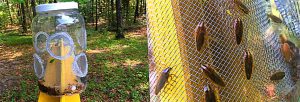Do you know which roach you are seeing in your yard? It may be the Asian cockroach, Blatella asahinai, instead of the more well-known urban pest, the German cockroach, Blatella germanica. Unlike the German cockroach, the Asian cockroach is commonly in mulch and leaf litter around your home-perhaps by the thousands.
Although only originally described from specimens collected in Japan in 1981, it was first reported in Florida by a pest control operator in 1986. Many insect populations in your yard, including the Asian cockroach, may vary year to year in terms of population numbers and densities. This year, higher than average populations of the Asian cockroach have been observed in Alachua County, Florida in urban-rural interface areas with significant mulch.

How can you avoid the Asian cockroach entering your home? Consider reviewing the doors and window sealing to your home. Also, the Asian cockroach is really attracted to bright and light surfaces, and so your security lights as well as the color of your home may add to the attractiveness of the Asian cockroach to fly to your home at night. Essentially, your home may be serving as a light beacon for these roaches at night, and the Asian cockroach is a very strong flier.
How do you know that you are dealing with the Asian cockroach instead of the German cockroach? Well, if you are suddenly noticing a small light brown (around 10 to 15 mm in size or ½ an inch) roach flying around your kitchen at night towards lights, and you have quite a bit of mulch outside-you may have Asian cockroaches in your mulch. Asian cockroaches are much less likely to infest homes than the German cockroach, but exclusion and sanitation in the home is important.
Want to know more about the Asian cockroach and German cockroach? Check out our UF entomology and Nematology Featured Creatures publication.
I wish to acknowledge Dr. Amanda Hodges for providing the pictures and some contents of the post.
 0
0
